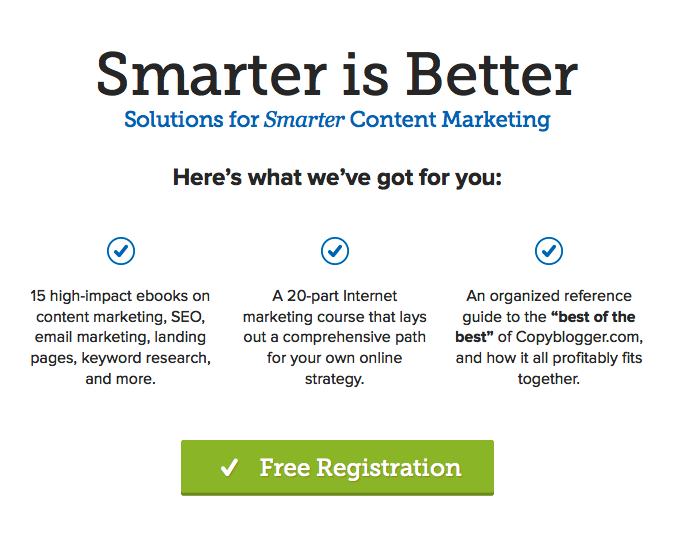After visitors read a post on your site, what do they read next? Do they stick around or abandon you? This is crucial. The more time visitors spend with your content, the better they get to know and trust you. Create the right setting for longer visits with recommendations and targeted offers in every post.
If you read Copyblogger (you should), you’ll be familiar with their style of blog post conclusions. Each one ends with a reading recommendation for another post. Those definitely help time on site. But I’m really impressed by the offer.

It’s bold, well-designed and absolutely clear about what you get. If I wasn’t a convert already, I’d totally click that. The steps below help you embed basic offers in a WordPress post using an image file and your landing page’s URL.
Get a Landing Page
First off, do you have anything to offer? No point going on if you don’t. Offers drive traffic to special landing pages where visitors share their contact information in order to access valuable, easy-to-use content you create.
Common types of downloads include checklists, worksheets, do-it-yourself tutorials or even collections of blog posts. Got anything like that? Find ways to package your expertise that visitors find useful. Then, create a landing page page on your site that explains the benefits of downloading your cool thing. Use Formstack to capture the contact info and deliver the download automatically.
Have questions about creating and sharing content online? Read our blogging strategy guide to get started.
Once you have your content and you’ve created a working landing page, copy the URL for the landing page. We’ll combine this with an image file later on.
Write and Design Your Offer
As in the Copyblogger example, your offer should use a bold headline and completely communicate the benefit of clicking the button. Get help from a writer to develop several versions you can test. Once the writing is done, work with a graphic designer to create a simple layout for your copy.
There are many lengthy books on writing and designing effective offer graphics and buttons. Some of them are probably even leather bound. I’ve listed a few of my favorite resources on content marketing below. Check those out for yourself, or better, consult a local marketing expert who already reads these on the daily.
- One of the best blogs about writing for the Internet is Copyblogger.
- The Content Marketing Institute runs another killer blog covering a wide range of topics.
- Try out Inbound.org, a Reddit-like network devoted to marketing tips and helpful articles.
For Roundpeg, our graphic designer made an image that fits full-width across the bottom of the blog post content area and includes a short call to action.
Create a Linked Image
Next, you’ll want to link that image to your landing page. If you know a little HTML, it’s easy to create your own version of the code below using your image and landing page’s URLs.
Make sure to enter this code with the Text editor.
However, you can cheat a little with WordPress by adding the image to your post using the Add Media interface. If you need help adding images to your posts, read these instructions for working with images in WordPress. Once you’re comfortable adding images, the steps below make it easy to link your image with a Custom URL.
- Click Add Media above the formatting toolbar and choose an image from your Media Library or upload a new image.
- Make sure you set the title and alt text for your image.
- Choose Custom URL for your Link To setting
- Enter the URL of your landing page.
- Click Insert to put the linked image into your post.
WordPress generates all the code for you and adds it in the right place. To see how it all comes together, click Preview in the Publish module.
Now your blog post concludes with an answer to the age old question, “What to read next?” And your visitors stay longer, know you better and might just become customers more often.
